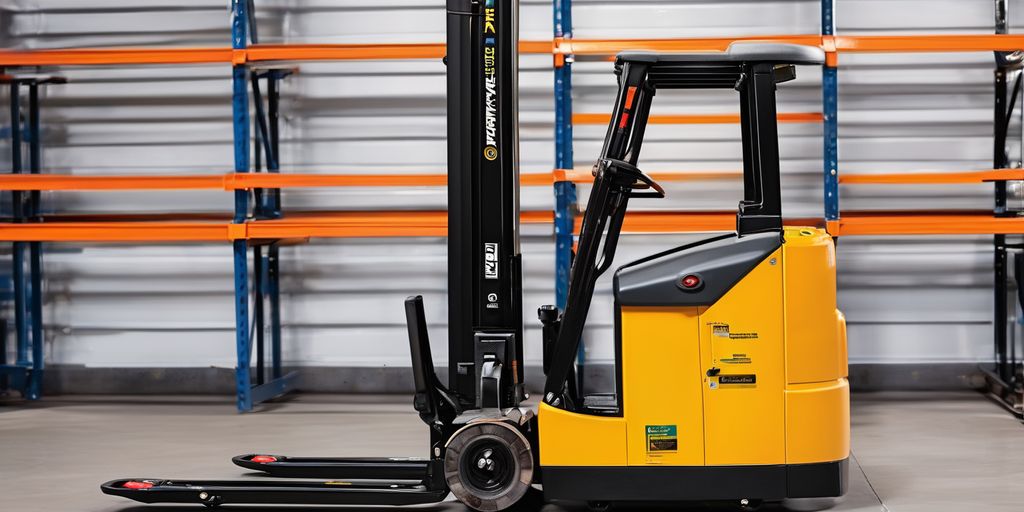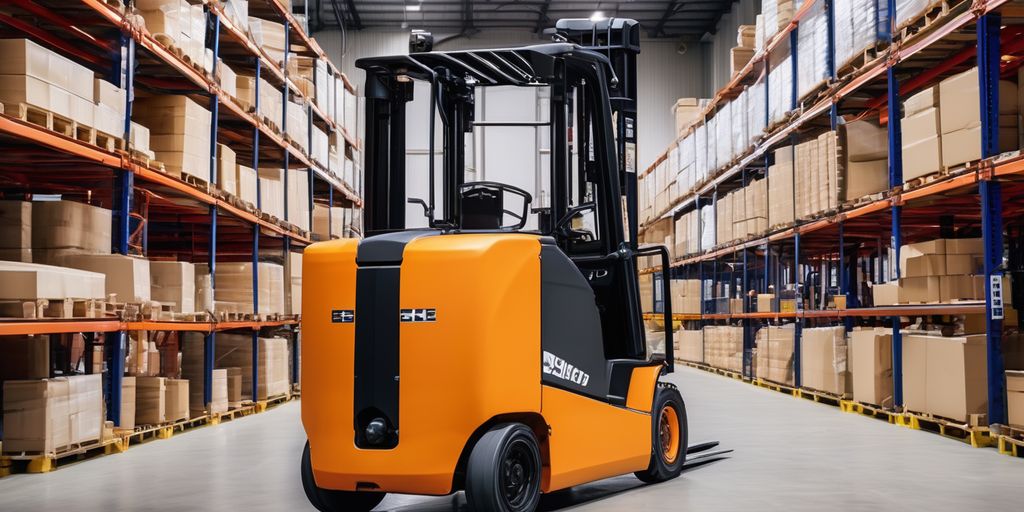Electric pallet jacks are essential tools in many warehouses, making it easier to move heavy loads. However, to use them safely, operators need to follow specific guidelines. This article covers important safety tips for operating electric pallet jacks, ensuring both efficiency and safety in the workplace.
Key Takeaways
- Always perform a pre-operation inspection to ensure the pallet jack is in good working condition.
- Proper training and certification are crucial for all operators.
- Follow safe operating practices, such as pushing instead of pulling the pallet jack.
- Regular battery maintenance is necessary to keep the pallet jack functioning properly.
- Handle loads carefully, ensuring they are stable and within weight limits.
Pre-Operation Inspection

Before using an electric pallet jack, it's crucial to perform a thorough pre-operation inspection. This step ensures the equipment is safe and ready for use, preventing potential hazards. Always fill out the pre-operation inspection sheet to confirm the pallet jack is in good working condition. If any issues are found, do not use the equipment and report it immediately.
Check Safety Devices
Ensure all safety devices are attached and functioning properly. This includes checking that all warning labels and data plates are in place and readable. Pay special attention to the emergency reverse control and the horn.
Inspect Controls
Test all operating controls before use. This includes:
- Raising and lowering the forks
- Checking the horn
- Testing the braking system
- Verifying forward and reverse controls
Examine Wheels and Forks
Inspect the wheels, tires, and forks for any damage or wear. Look for cracks, leaks, or other signs of damage. Make sure the wheels and forks are in good condition to ensure smooth and safe operation.
A thorough pre-operation inspection is your first line of defense against potential hazards. Always take the time to perform this check to ensure a safe working environment.
Proper Training for Operators
Ensuring that operators are well-trained is crucial for maximizing warehouse efficiency with electric pallet jacks. Proper training not only enhances safety but also boosts productivity.
Certification Requirements
Operators must meet specific certification requirements to operate electric pallet jacks safely. Formal and hands-on safety instruction courses are essential to satisfy OSHA requirements. Employers should document all training and results, even though actual certificates are not necessary.
Hands-On Training
Hands-on training is vital for operators to gain practical experience. This training can be done on-site and on-the-job, typically lasting between 3-6 months. During this period, operators learn to handle the equipment safely and efficiently.
Refresher Courses
To maintain high safety standards, operators should undergo refresher courses regularly. Employers must recertify operators every three years to ensure they remain competent and up-to-date with safety protocols.
Regular training and recertification help in maintaining a safe and efficient warehouse environment.
Safe Operating Practices

Push, Don't Pull
When using an electric pallet jack, always push the load instead of pulling it. Pushing provides better control and reduces the risk of injury. Pulling can strain your back and make it harder to stop the pallet jack quickly.
Mind Your Feet and Hands
Keep your feet and hands clear of the pallet jack's moving parts. This helps prevent accidents and injuries. Always be aware of where your hands and feet are, especially when the pallet jack is in motion.
Navigating Inclines
When moving up or down an incline, be extra cautious. Move slowly and keep the load stable. If the incline is steep, it might be safer to use a different method to move the load. Safety should always come first when dealing with slopes.
Battery Maintenance

Maintaining the battery of your electric pallet jack is crucial for ensuring its longevity and performance. Regular battery maintenance can prevent unexpected downtimes and accidents in the warehouse.
Regular Charging
Always make sure to fully charge the battery before operating the pallet jack. A low charge can cause the lift to stop midway through a task, leading to unnecessary downtime and increased risk of accidents. Use the amperage gauge on the machine to check the charge capacity.
Battery Checkups
Regular checkups are essential to ensure the battery is in good condition. Inspect the battery for any signs of wear or damage. Regular maintenance can help identify issues early and extend the battery's life.
Safe Charging Practices
When charging the battery, always follow the manufacturer's guidelines. Ensure the charging area is clean and free from any flammable materials. Proper charging practices can significantly reduce the risk of accidents and improve the battery's performance.
Load Handling
Check Load Stability
Before moving any load, make sure it is stable and secure. Unstable loads can tip over, causing accidents and damage. Always check that the load is evenly distributed and not leaning to one side.
Weight Limits
Every electric pallet jack has a weight limit. Never exceed this limit, as it can lead to equipment failure and accidents. Refer to the manufacturer's guidelines to know the maximum weight your pallet jack can handle.
Balanced Loading
When loading the pallet jack, ensure the weight is balanced. Place heavier items at the bottom and lighter ones on top. This helps in maintaining stability and prevents the load from shifting during movement.
Always prioritize the safety of pedestrians in the warehouse. Operators should be vigilant and always yield to pedestrians. Designated pedestrian walkways should be kept clear at all times.
Storage and Parking
Safe Storage Locations
When storing electric pallet jacks, always lower the forks to the ground. This makes the pallet truck stable and prevents accidental rolling. Park the pallet jack in its designated spot when not in use. That should be out of the way but still accessible without straining. Many facilities with multiple pallet trucks have specific parking stalls. Under open shelves or behind stairwells are good locations for parked jacks.
Avoid Pedestrian Walkways
Ensure that parked pallet jacks do not block any exits, aisles, or emergency equipment. This is crucial for maintaining clear and safe pathways for pedestrians. Maximizing warehouse efficiency with electric pallet jacks is essential for modern warehouses. Training, safety measures, and strategic layout optimization are key for improved productivity and safety.
Recharging Protocols
When recharging electric pallet jacks, always follow the manufacturer's guidelines. Disconnect the battery or remove the key if the unit will be out of sight to prevent unauthorized use. Regularly check the battery and charging equipment for any signs of wear or damage to ensure safe and efficient operation.
Navigating Warehouse Traffic
Approaching Corners
When driving an electric pallet jack, always slow down when you get close to corners. Going too fast around a corner can cause accidents. Make sure to look both ways before you turn to avoid hitting someone or something.
Using Warehouse Entries and Exits
Some warehouses have big plastic flaps for doors. Be careful when you go through these doors. New drivers might not know the traffic flow and could bump into you. Always pay attention when you enter or exit.
Communication with Other Operators
Clear communication is key in a busy warehouse. Use hand signals or radios to talk to other operators. This helps everyone know what to do and keeps the work area safe.
In a busy warehouse, good communication can prevent many accidents.
Conclusion
Operating electric pallet jacks safely in your warehouse is crucial for preventing accidents and ensuring smooth operations. Always remember to inspect the equipment before use, follow proper training protocols, and be mindful of your surroundings. Regular maintenance and adherence to safety guidelines can go a long way in keeping both the operators and the warehouse environment safe. By implementing these safety tips, you can help create a safer and more efficient workplace for everyone.
Frequently Asked Questions
What are the essential pre-operation checks for an electric pallet jack?
Before using an electric pallet jack, always inspect the safety devices, controls, wheels, and forks. Ensure that the emergency shut-offs, horns, and brakes are working properly.
Is certification required to operate an electric pallet jack?
Yes, operators need to be certified. This includes completing hands-on training and taking refresher courses to ensure they are up-to-date with safety practices.
How should I handle the pallet jack when moving loads?
Always push the pallet jack rather than pulling it. Be cautious of your feet and hands, and move in reverse when navigating inclines.
What should I do to maintain the battery of an electric pallet jack?
Regularly charge the battery and perform checkups to ensure it is in good condition. Follow safe charging practices to avoid any hazards.
How can I ensure the load is safe to move with a pallet jack?
Check that the load is stable, within the weight limits, and balanced properly on the forks before moving it.
Where should I store the electric pallet jack when not in use?
Store the pallet jack in a safe location, away from pedestrian walkways. Make sure it is plugged in for recharging so it's ready for the next use.




Leave a comment
This site is protected by hCaptcha and the hCaptcha Privacy Policy and Terms of Service apply.